When choosing ESD packaging, you'll find several options with distinct protective features. Anti-static bags offer basic protection for low-sensitivity components, while conductive materials actively channel static away from sensitive electronics. Static-dissipative packaging provides controlled static release with surface resistance between 10^5 and 10^11 ohms. For maximum protection, shielding materials like metallized bags create a Faraday Cage effect, ideal for highly sensitive components. Each material type varies in cost, durability, and moisture resistance, with premium options featuring multi-layer construction and superior surface resistivity ratings. Understanding these key differences will help you make the most cost-effective choice for your specific needs.
Common ESD Packaging Types
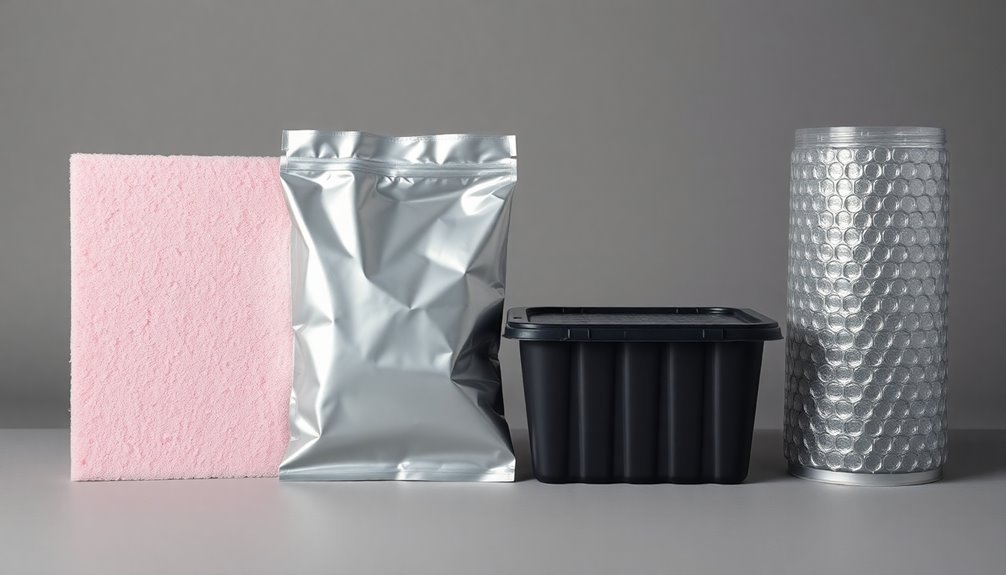
When protecting electronic components from static electricity, you'll encounter four main types of ESD packaging: anti-static, conductive, dissipative, and shielding materials. Each type serves specific protection needs and sensitivity levels.
Anti-static packaging prevents static buildup but won't protect against external charges. You'll find it's ideal for low-sensitivity electronics and components used in ESD-protected areas, like nuts and bolts. It's typically made from polythene or PET films with special additives. Intimate packaging solutions often use anti-static materials due to their direct contact with sensitive products. This type is particularly prevalent as anti-static materials dominate the ESD packaging applications market.
Conductive materials provide a direct path to ground, actively conducting static charges away from stored items. You'll want to use these carbon-loaded plastics or corrugated cardboard options, like Corstat and Corriplast, for highly sensitive electronics.
Dissipative packaging slows down static electricity flow, reducing charge strength. With surface resistance between 10^5 and 10^11 ohms, it's perfect for moderately sensitive components. You'll see this type in foams and coated plastics.
Shielding materials create a protective barrier using the Faraday Cage effect. You'll need these metallized bags and containers when shipping or storing highly sensitive electronics that require maximum protection from electrostatic discharge.
Static Protection Levels Explained
Understanding the various packaging types leads naturally to exploring static protection levels themselves. When you're selecting ESD packaging, you'll need to take into account the sensitivity levels of your electronic components, which are measured according to ANSI/ESD S20.20 and IEC 61350-5-1 standards.
These levels are determined by testing devices against Human Body Model (HBM) and Charged Device Model (CDM) thresholds, typically set at 100V and 200V respectively. You'll need to match your packaging's protection level to your most sensitive component, as some electronics can be damaged by as little as 10 volts. Regular ESD training for staff handling these components is crucial for maintaining protection effectiveness. Modern microelectronics have made device-level protection increasingly critical due to their heightened sensitivity to static discharge.
The packaging you choose must incorporate appropriate ESD protection mechanisms, such as low-impedance paths to ground and proper surface resistivity to prevent static charge accumulation. Your packaging should effectively shield against all three types of ESD failures: soft failures, latent defects, and catastrophic failures.
When evaluating protection levels, you'll want to take into consideration how the packaging works with your overall ESD-protected area (EPA) strategy. This includes ensuring your packaging materials complement other protection elements like TVS diodes, suppressors, and proper grounding systems in your facility.
Material Composition and Properties
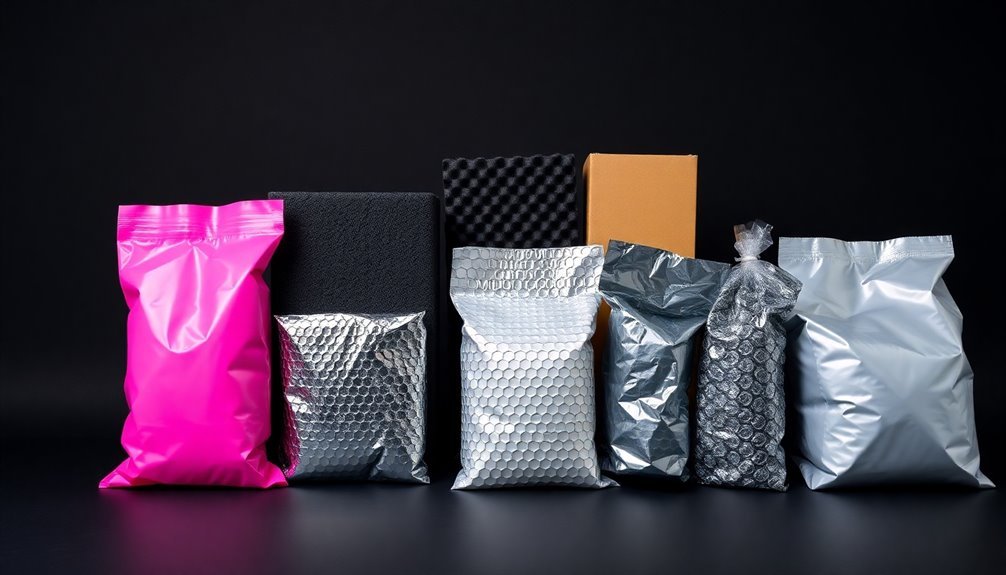
Material composition directly impacts the effectiveness of ESD packaging solutions. When you're selecting ESD packaging materials, you'll find four main categories, each with distinct properties and protective capabilities based on their unique compositions.
Anti-static packaging uses polyethylene with specialized additives to prevent static buildup, offering basic protection that's independent of humidity levels. These materials help prevent costly part failures which account for approximately 25% of electronic component failures. Metal-out shielding bags provide superior protection for critical applications.
Conductive materials incorporate carbon-loaded polyethylene, creating a pathway for static electricity to flow away from sensitive components.
Dissipative materials slow down static electricity flow through their specialized polymer composition, while shielding materials combine multiple layers including aluminum, polyester, and static-dissipative polyethylene for maximum protection.
- Picture anti-static materials as a barrier that stops static charges from forming – like a raincoat preventing water from collecting.
- Think of conductive materials as lightning rods, channeling harmful static away from your components.
- Visualize dissipative materials as speed bumps, controlling the flow of static charges.
- See shielding materials as a fortress with multiple defensive walls, protecting your most sensitive electronics.
Each material's composition determines its shelf-life, cost, and protective capabilities, making it essential to match your specific needs with the right material properties.
Moisture Barrier Performance Analysis
Building upon the composition of ESD packaging materials, the moisture barrier performance of these materials represents a key factor in protecting sensitive electronic components.
When you're selecting moisture barrier bags, you'll need to take into account the Moisture Vapor Transmission Rate (MVTR), which measures how quickly water vapor passes through the material. Following JEDEC J-STD-033 standards ensures optimal moisture barrier performance for sensitive components. Surface Mount Devices require special attention due to their high sensitivity to moisture damage.
You'll find that thicker materials generally provide better moisture protection. For instance, 7.0 mil materials achieve an MVTR of 0.005 g/100in²/24hrs, while 3.6 mil materials provide 0.02 g/100in²/24hrs. The lower the MVTR value, the less desiccant you'll need and the longer your dry storage times will be.
To guarantee effective moisture protection, you'll want to check that your bags meet industry standards of <0.02 g/100in²/24hrs for high barrier performance.
Aluminized polyester bags typically offer superior moisture protection compared to other materials. You should also take into account the bag's puncture resistance, as it needs to withstand handling of trays and reels.
Look for bags with puncture strength exceeding 20 lb to maintain barrier integrity. When properly sealed, these bags create a reliable moisture barrier while providing essential ESD protection for your electronic components.
Cost Versus Protection Benefits
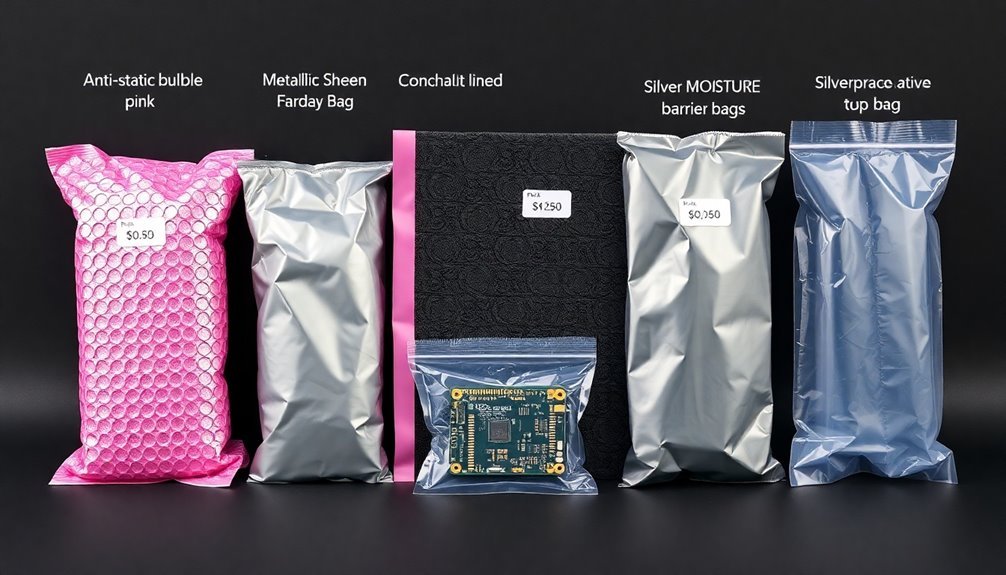
When you're seeking basic ESD protection on a budget, antistatic poly bags offer an economical starting point despite their limited shielding capabilities. Concerns arise since the antistatic coating wears over time, reducing protective effectiveness.
For critical electronic components, you'll find the higher cost of metallized shielding bags justified by their superior Faraday cage protection and extensive ESD defense features. These bags effectively prevent overheating damage during rapid temperature changes in transport.
While antistatic bags may seem cost-effective initially, the reusability and durability of conductive and metallized shielding bags often provide better long-term value for your investment.
Budget-Friendly Basic Protection
In today's competitive market, finding the right balance between cost and protection in ESD packaging doesn't have to break your budget. By choosing basic anti-static bags for non-sensitive components and exploring reusable options, you'll maximize your investment while maintaining essential protection levels.
Consider these cost-effective ESD packaging solutions:
- Polyethylene and PET bags that provide basic protection while keeping costs low
- Anti-static bubble wrap that combines cushioning with static protection
- Corrugated plastic containers that offer durability and reusability
- Static-dissipative PVC materials that guarantee controlled static release
You'll find that purchasing ESD materials in bulk often leads to significant savings, while custom sizing helps eliminate waste and unnecessary expenses.
Basic protection options like anti-static tubing and sheeting work well for wrapping components, offering adequate protection at a lower price point. When you're handling less sensitive electronics, these budget-friendly solutions deliver the protection you need while keeping operational costs in check.
Premium Performance Worth Price
Superior ESD protection demands premium packaging solutions that justify their higher costs through enhanced safeguards and reliability. When you're handling sensitive electronics, premium ESD packaging materials offer extensive protection through multiple mechanisms, including the Faraday Cage effect and advanced moisture barriers.
These high-end solutions don't just protect against static discharge; they shield your components from electromagnetic interference while providing superior physical protection.
While you'll pay more upfront for premium materials, their durability and reusability often make them cost-effective in the long run. Premium options like specialized conductive bags and high-grade anti-static foam maintain their protective properties for over five years, even under varying humidity conditions.
You'll find that these materials resist degradation and maintain their physical integrity, ensuring consistent ESD protection throughout their lifecycle.
For critical applications, premium materials with surface resistivity ratings below 1.0 x 10^3 ohm-cm provide the highest level of protection. When you're selecting premium packaging, you'll benefit from specialized materials like Corstat and Corriplast, which combine multiple protective features.
These solutions are particularly valuable when you need to safeguard high-value components where failure isn't an option.
Long-Term Investment Analysis
Three critical factors drive the long-term investment analysis of ESD packaging: initial cost, protection level, and product lifespan.
While antistatic poly bags offer a budget-friendly solution, their limited shelf life and basic protection make them suitable only for non-sensitive items within EPAs. In contrast, static shielding bags provide thorough protection through their multi-layer construction and Faraday Cage effect.
When you're evaluating your long-term ESD packaging investment, consider these key protection features:
- Shielding bags disperse electromagnetic charges across their exterior, preventing damage to sensitive components
- Multi-layer construction combines aluminum shielding, polyester, and static dissipative polyethylene for maximum protection
- Extended shelf life of over two years guarantees consistent performance and reliability
- Compliance with ANSI/ESD standards assures reliable protection for valuable electronics
While shielding bags require a higher upfront investment, they'll save you money in the long run by preventing costly component damage.
Their reusability, durability, and superior protection make them a cost-effective choice for protecting valuable electronic components.
You'll find that the initial cost difference becomes insignificant when compared to the potential expense of replacing damaged electronics.
Environmental Impact of Materials
The environmental impact of ESD packaging materials raises several critical concerns for manufacturers and consumers alike. Most ESD packaging relies on polythene or PET films with static-preventing additives, which contribute considerably to plastic pollution and waste.
You'll find that these materials often come from non-renewable resources, making their production environmentally unsustainable.
When you're considering waste management, you'll face challenges with proper disposal and recycling. The specialized coatings and additives in ESD packaging make it difficult to process through standard recycling streams, and incorrect disposal can lead to environmental contamination.
While you can reuse some materials, it's not always practical or possible.
You'll find some promising eco-friendly alternatives emerging in the market. Cardboard-based solutions like Corstat and corrugated plastic options like Corriplast offer more sustainable choices.
Companies are also exploring biodegradable ESD packaging, though these developments are still in early stages.
While you can opt for recycled materials in some cases, the industry's strict performance requirements often limit the use of fully sustainable alternatives.
Research continues to focus on developing more environmentally responsible solutions that maintain necessary anti-static properties.
Application Selection Guidelines
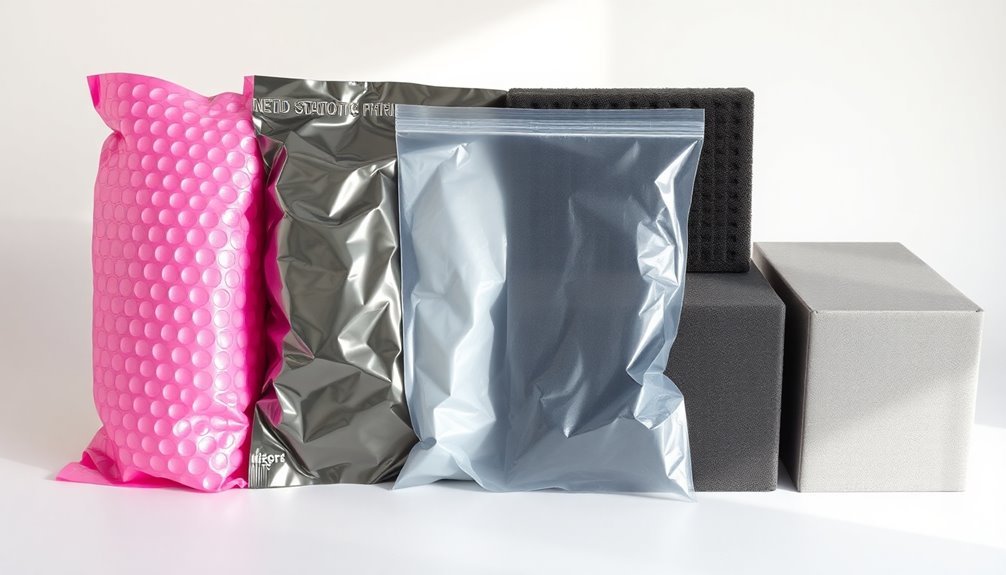
Selecting appropriate ESD packaging materials requires a systematic appraisal of your product's specific needs and environmental conditions. When choosing the right protection, you'll need to contemplate your component's ESD sensitivity level and the type of contact required – whether proximity or intimate packaging is needed.
Start by evaluating these key material properties for your application:
- Anti-static materials that prevent charge buildup, ideal for basic protection of moderately sensitive components
- Conductive materials that quickly channel charges away, perfect for handling highly sensitive electronics
- Dissipative materials that control static flow, suitable for components requiring gradual charge reduction
- Shielding materials that create protective barriers against both ESD and EMI, essential for critical components
You'll want to match your packaging form to your product's requirements, contemplating factors like surface resistivity ratings (typically no more than 1.0 x 10^3 ohm-cm) and physical protection needs.
Don't forget to verify compliance with IEC 61340 standards. Consider practical aspects like moisture protection requirements, especially if you're operating in humid environments, and whether you need custom-sized solutions for unique components.
Frequently Asked Questions
How Long Can ESD Packaging Materials Maintain Their Protective Properties During Storage?
Your ESD packaging can last 1-5 years, with anti-static bags lasting over 5 years and shielding bags over 2 years. You'll get longer life from non-humidity dependent materials like conductive bags.
Can ESD Packaging Be Reused Without Compromising Its Protective Effectiveness?
You can reuse conductive and shielding bags if they're undamaged and properly cleaned, but avoid reusing anti-static bags as their protective coating wears off. Always inspect packaging before reuse to guarantee protection.
What Temperature Ranges Can Different ESD Packaging Materials Safely Withstand?
You'll find anti-static poly bags work up to 60°C, foam to 80°C, and metallized shielding bags to 100°C. Conductive bags handle up to 70°C, while corriplast plastic stays effective until 85°C.
Are There Specific Cleaning Methods Recommended for Maintaining Reusable ESD Packaging?
You'll want to use deionized water with damp cloth wiping, avoid ammonia cleaners, and use ESD-safe wipes. Don't scrub or soak the packaging. Always dry thoroughly with lint-free cloths after cleaning.
How Do Different Closure Methods Affect the Overall ESD Protection Performance?
Your choice of closure method directly impacts ESD protection. Ziplock seals offer consistent reusable protection, while adhesive seals provide better Faraday Cage effects. Damaged or improperly sealed closures can compromise your ESD safeguards.
In Summary
When you're selecting ESD packaging, you'll need to balance protection level, cost, and sustainability. While metallized bags offer superior protection, they're pricier than pink poly alternatives. You'll find static dissipative boxes work best for heavy items, while moisture barrier bags excel for sensitive components. Consider your product's sensitivity, shipping conditions, and budget to make the best choice for your ESD packaging needs.

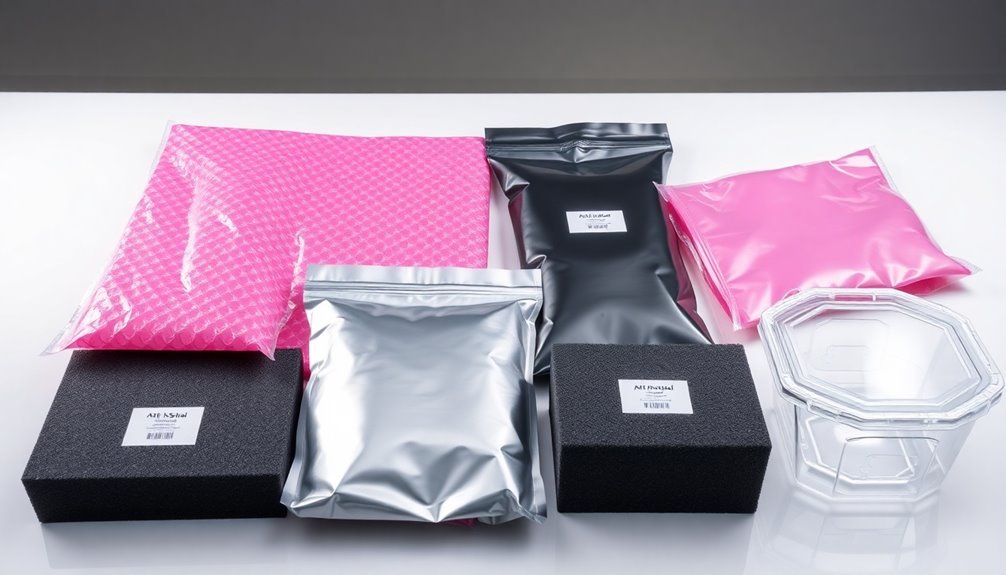



Leave a Reply